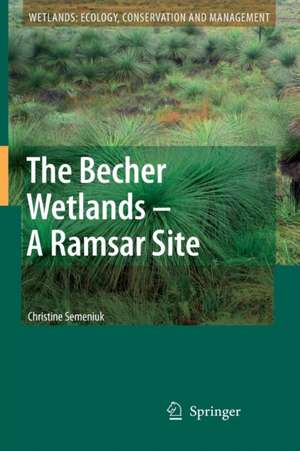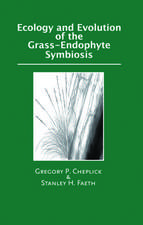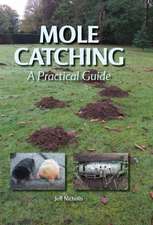The Becher Wetlands - A Ramsar Site: Evolution of Wetland Habitats and Vegetation Associations on a Holocene Coastal Plain, South-Western Australia: Wetlands: Ecology, Conservation and Management, cartea 1
Autor Christine Semeniuken Limba Engleză Paperback – 23 aug 2016
| Toate formatele și edițiile | Preț | Express |
|---|---|---|
| Paperback (1) | 1235.76 lei 6-8 săpt. | |
| SPRINGER NETHERLANDS – 23 aug 2016 | 1235.76 lei 6-8 săpt. | |
| Hardback (1) | 1246.47 lei 6-8 săpt. | |
| SPRINGER NETHERLANDS – 17 ian 2007 | 1246.47 lei 6-8 săpt. |
Preț: 1235.76 lei
Preț vechi: 1507.01 lei
-18% Nou
Puncte Express: 1854
Preț estimativ în valută:
236.49€ • 244.31$ • 196.82£
236.49€ • 244.31$ • 196.82£
Carte tipărită la comandă
Livrare economică 26 martie-09 aprilie
Preluare comenzi: 021 569.72.76
Specificații
ISBN-13: 9789401776578
ISBN-10: 9401776571
Pagini: 681
Ilustrații: XV, 681 p.
Dimensiuni: 155 x 235 mm
Greutate: 0.96 kg
Ediția:Softcover reprint of the original 1st ed. 2007
Editura: SPRINGER NETHERLANDS
Colecția Springer
Seria Wetlands: Ecology, Conservation and Management
Locul publicării:Dordrecht, Netherlands
ISBN-10: 9401776571
Pagini: 681
Ilustrații: XV, 681 p.
Dimensiuni: 155 x 235 mm
Greutate: 0.96 kg
Ediția:Softcover reprint of the original 1st ed. 2007
Editura: SPRINGER NETHERLANDS
Colecția Springer
Seria Wetlands: Ecology, Conservation and Management
Locul publicării:Dordrecht, Netherlands
Cuprins
Methods Andterminology.- Regional Setting.- Wetland Descriptions.- Development of Wetland Proto-Type: Geomorphology, Basal Sheet, Hydrology.- Wetland Sedimentologyandstratigraphy.- Linkage Between Stratigraphyand Hydrology.- Wetland Hydrology.- Wetland Hydrochemistry.- Vegetation.- Vegetationhistory.- Synthesis.
Textul de pe ultima copertă
This book is a landmark study of the Holocene evolution and functioning of a suite of seasonal wetland basins in the temperate coastal zone of Western Australia. In 2001, a series of discrete small scale wetlands on the Becher cuspate foreland in Western Australia, were nominated as a Ramsar site because of their scientific values. These values pertained to their setting, their method of formation and deepening, their history of infilling, their complex hydrological mechanisms, and their dynamic hydrochemical and vegetation responses. The wetlands were the subjects of intense curiosity, observation, measurement, and experiment, for over 10 years. The results of this interest and passion are presented here in order to demonstrate the considerable importance of what lay beneath the ordinary surface.
Amongst the new ideas presented in the book are the importance of stratigraphy in understanding wetland development, the significance of physiographic setting in determining wetland development, and the unravelling of several different evolutionary pathways in wetlands of the same basic origin.
The book would be of interest to a great variety of readers such as university researchers/students in the fields of geography, ecology, environmental science/engineering, botany and biology, and also would be of benefit to water/soil resource managers, land management planners, conservation agencies and environmental management/protection agencies.
Amongst the new ideas presented in the book are the importance of stratigraphy in understanding wetland development, the significance of physiographic setting in determining wetland development, and the unravelling of several different evolutionary pathways in wetlands of the same basic origin.
The book would be of interest to a great variety of readers such as university researchers/students in the fields of geography, ecology, environmental science/engineering, botany and biology, and also would be of benefit to water/soil resource managers, land management planners, conservation agencies and environmental management/protection agencies.
Caracteristici
Ramsar wetlands of international importance Innovative approach to wetland science Multi-disciplinary study Imaginative and clear illustrations conceptualising the main themes of the work
























